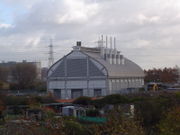London sewerage system
2008/9 Schools Wikipedia Selection. Related subjects: Engineering
The London sewerage system is part of the water infrastructure serving London. The modern roots of the system were first developed during the late 19th century, but as London has grown the system has been expanded and needs further investment.
History
In the early 19th century the River Thames was practically an open sewer, with disastrous consequences for public health in London, including numerous cholera epidemics. Proposals to modernise the sewerage system had been put forward in 1856, but were shelved due to lack of funds. However, after The Great Stink of 1858, Parliament realised the urgency of the problem and resolved to create a modern sewerage system.
Joseph Bazalgette, a civil engineer and Chief Engineer of the Metropolitan Board of Works, was given responsibility for the work. He designed an extensive underground sewerage system that diverted waste to the Thames Estuary, downstream of the main centre of population. Six main interceptory sewers, totalling almost 100 miles (160 km) in length, were constructed, some incorporating stretches of London's 'lost' rivers. Three of these sewers were north of the river, the southernmost, low-level one being incorporated in the Thames Embankment. The Embankment also allowed new roads to reduce traffic congestion, new public gardens, and the Circle Line of the London Underground.
The intercepting sewers, constructed between 1859 and 1865, were fed by 450 miles (720 km) of main sewers that, in turn, conveyed the contents of some 13,000 miles (21,000 km) of smaller local sewers. Construction of the interceptor system required 318 million bricks, 880,000 cubic yards (670,000 m³) of concrete and mortar, and excavation of over 3.5 million tonnes of earth.
Gravity allows the sewage to flow eastwards, but in places such as Chelsea, Deptford and Abbey Mills, pumping stations were built to raise the water and provide sufficient flow. Sewers north of the Thames feed into the Northern Outfall Sewer, which feeds into a major treatment works at Beckton. South of the river, the Southern Outfall Sewer extends to a similar facility at Crossness.
In the 20th century, major improvements were made to the sewerage system to reduce pollution of the Thames Estuary and the North Sea.
Modern development needs
Victorian pipes now comprise less than 1% of the total sewerage network in London.
The original system was designed to cope with up to 6.5 mm (1/4”) of rainfall within the catchment area, and supported a smaller population than today’s. London's growth has therefore put pressure on the capacity of the sewerage system. During storms, for example, high levels of rainfall (in excess of 6 mm) in a short period of time can overwhelm the system. Sewers and treatment works are unable to cope with the large volumes of rainwater entering the system. Rainwater mixes with sewage in combined sewers and excess mixed water is discharged into the Thames. If this does not happen quickly enough, localised flooding occurs (surcharge). Such sanitary sewer overflow can mean streets becoming flooded with a mixture of water and sewage, causing a health risk.
Increasing the carrying capacity of London’s sewerage system has been debated for some years. Proposals for the ' Thames Tideway' include a wide diameter storage-and-transfer tunnel (internal diameters of 7.2 m and 9 m have been suggested), 22 miles (35 km) long, underneath the riverbed of the Thames between Hammersmith in the west and Beckton/ Crossness in the east, but as the cost of such a megaproject is likely to be substantial (estimated at £1.7 billion in 2004), investment decisions have been slow to be forthcoming. As of March 2007 it has been announced by the Mayor of London that the project will proceed with completion expected by 2020.
Because design and construction of such a tunnel will take an estimated 15 years, a shorter-term (and slightly lower cost) interim solution has also been developed. This £1.6 billion scheme (2006 prices) involves two shorter tunnels (one taking storm water from Hammersmith to Battersea for treatment or storage, the other carrying water from Abbey Mills south to the river at Beckton) and improvements to associated treatment facilities.

